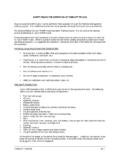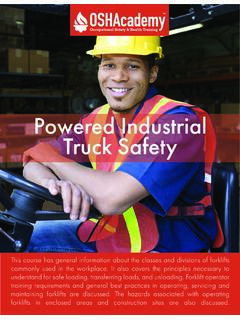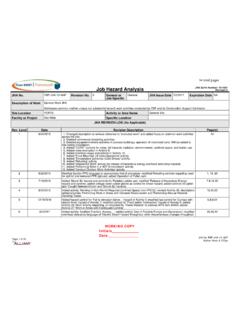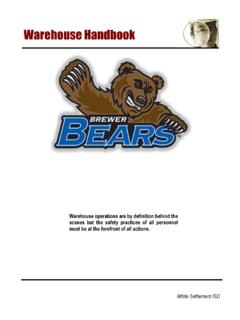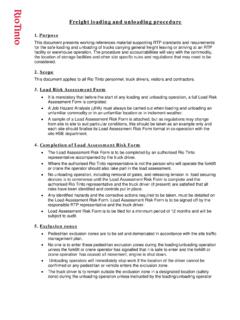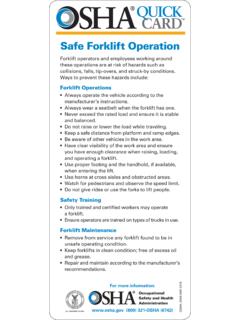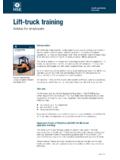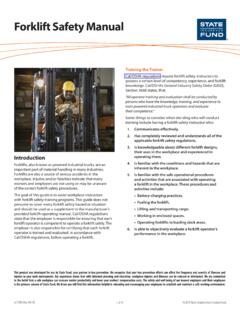Transcription of OSHA 3252-05N 2005
1 OSHA 3252-05N 2005 WORKER SAFETY SERIESC onstructionNearly million people work at approximate-ly 252,000 construction sites across the nationon any given day. The fatal injury rate for theconstruction industry is higher than the nationalaverage in this category for all hazards for workers in constructioninclude: Falls (from heights); Trench collapse; Scaffold collapse; Electric shock and arc flash/arc blast; Failure to use proper personal protective equipment; and Repetitive motion Safety and Health Department of & SolutionsFor construction, the 10 OSHA stan-dards most frequently included in theagency s citations in FY 2004 were: 1 . Scaffolding2. Fall protection (scope, application,definitions)3. Excavations (general requirements)4.
2 Ladders5. Head protection6. Excavations (requirements for protective systems)7 . Hazard communication8. Fall protection (training require-ments)9. Construction (general safety andhealth provisions)10. Electrical (wiring methods, designand protection)Occupational Safety and Health AdministrationScaffoldingHazard:When scaffolds are not erected orused properly, fall hazards can occur. million construction workers frequentlywork on scaffolds. Protecting these workersfrom scaffold-related accidents would preventan estimated 4,500 injuries and 50 fatalitieseach : Scaffold must be sound, rigid and sufficientto carry its own weight plus four times themaximum intended load without settling ordisplacement. It must be erected on solidfooting.
3 Unstable objects, such as barrels, boxes,loose bricks or concrete blocks must not beused to support scaffolds or planks. Scaffold must not be erected, moved, dis-mantled or altered except under the super-vision of a competent person. Scaffold must be equipped with guardrails,midrails and toeboards. Scaffold accessories such as braces, brack-ets, trusses, screw legs or ladders that aredamaged or weakened from any causemust be immediately repaired or replaced. Scaffold platforms must be tightly plankedwith scaffold plank grade material or equiv-alent. A competent person must inspect thescaffolding and, at designated intervals,reinspect it. Rigging on suspension scaffolds must beinspected by a competent person beforeeach shift and after any occurrence thatcould affect structural integrity to ensurethat all connections are tight and that no2 WORKER SAFETY SERIESO ccupational Safety and Health Administrationdamage to the rigging has occurred sinceits last use.
4 Synthetic and natural rope used in suspen-sion scaffolding must be protected fromheat-producing sources. Employees must be instructed about thehazards of using diagonal braces as fall protection. Scaffold can be accessed by using laddersand stairwells. Scaffolds must be at least 10 feet from electric power lines at all Safety and Health AdministrationOccupational Safety and Health AdministrationFall ProtectionHazard:Each year, falls consistently accountfor the greatest number of fatalities in theconstruction industry. A number of factors areoften involved in falls, including unstableworking surfaces, misuse or failure to use fallprotection equipment and human have shown that using guardrails, fallarrest systems, safety nets, covers andrestraint systems can prevent many deathsand injuries from : Consider using aerial lifts or elevated plat-forms to provide safer elevated workingsurfaces; Erect guardrail systems with toeboards andwarning lines or install control line systemsto protect workers near the edges of floorsand roofs; Cover floor holes; and/or Use safety net systems or personal fallarrest systems (body harnesses).
5 4 WORKER SAFETY SERIESO ccupational Safety and Health AdministrationLaddersHazard:Ladders and stairways are anothersource of injuries and fatalities among con-struction workers. OSHA estimates that thereare 24,882 injuries and as many as 36 fatali-ties per year due to falls on stairways and lad-ders used in construction. Nearly half of theseinjuries were serious enough to require timeoff the : Use the correct ladder for the task. Have a competent person visually inspect aladder before use for any defects such as: Structural damage, split/bent side rails,broken or missing rungs/steps/cleats andmissing or damaged safety devices; Grease, dirt or other contaminants thatcould cause slips or falls; Paint or stickers (except warning labels)that could hide possible defects.
6 Make sure that ladders are long enough tosafely reach the work area. Mark or tag ( Do Not Use ) damaged ordefective ladders for repair or replacement,or destroy them immediately. Never load ladders beyond the maximumintended load or beyond the manufacturer srated capacity. Be sure the load rating can support theweight of the user, including materials andtools. Avoid using ladders with metallic compo-nents near electrical work and overheadpower Safety and Health AdministrationStairwaysHazard:Slips, trips and falls on stairways area major source of injuries and fatalitiesamong construction : Stairway treads and walkways must be freeof dangerous objects, debris and materials. Slippery conditions on stairways and walk-ways must be corrected immediately.
7 Make sure that treads cover the entire stepand landing. Stairways having four or more risers or ris-ing more than 30 inches must have at leastone SAFETY allowable slopes for excavationsless than 20 ft. ( m) based on soil type and angleto the horizontal are as follows:TABLE V:2-1. ALLOWABLE SLOPESS ource: OSHA Technical Manual, Section V, Chap. 2, Excavations:Hazard Recognition in Trenching and Shoring (Jan. 1999).Occupational Safety and Health AdministrationTrenchingHazard:Trench collapses cause dozens of fatal-ities and hundreds of injuries each deaths rose in : Never enter an unprotected trench. Always use a protective system for trenches 5feet deep or greater. Employ a registered professional engineer todesign a protective system for trenches 20feet deep or greater.
8 Protective Systems: Sloping to protect workers by cutting backthe trench wall at an angle inclined awayfrom the excavation not steeper than aheight/depth ratio of 112:1, according to thesloping requirements for the type of typeHeight/Depth ratio Slope angleStable RockVertical90 (granite or sandstone)Type A34:153 (clay)Type B1:145 (gravel, silt)Type C112:134 (sand)Type A (short-term)12:163 (For a maximum excavation depth of 12 ft.)Occupational Safety and Health Administration Shoring to protect workers by installingsupports to prevent soil movement fortrenches that do not exceed 20 feet indepth. Shielding to protect workers by usingtrench boxes or other types of supportsto prevent soil cave-ins. Always provide a way to exit a trench--suchas a ladder, stairway or ramp--no more than25 feet of lateral travel for employees in thetrench.
9 Keep spoils at least two feet back from theedge of a trench. Make sure that trenches are inspected by acompetent person prior to entry and afterany hazard-increasing event such as a rain-storm, vibrations or excessive SAFETY SERIESO ccupational Safety and Health AdministrationCranesHazard:Significant and serious injuries mayoccur if cranes are not inspected before useand if they are not used properly. Often theseinjuries occur when a worker is struck by anoverhead load or caught within the crane sswing radius. Many crane fatalities occurwhen the boom of a crane or its load linecontact an overhead power : Check all crane controls to insure properoperation before use. Inspect wire rope, chains and hook for anydamage.
10 Know the weight of the load that the craneis to lift. Ensure that the load does not exceed thecrane s rated capacity. Raise the load a few inches to verify balanceand the effectiveness of the brake system. Check all rigging prior to use; do not wraphoist ropes or chains around the load. Fully extend outriggers. Do not move a load over workers. Barricade accessible areas within thecrane s swing radius. Watch for overhead electrical distributionand transmission lines and maintain a safeworking clearance of at least 10 feet fromenergized electrical Safety and Health AdministrationHazard CommunicationHazard:Failure to recognize the hazardsassociated with chemicals can cause chemicalburns, respiratory problems, fires and : Maintain a Material Safety Data Sheet(MSDS) for each chemical in the facility.










